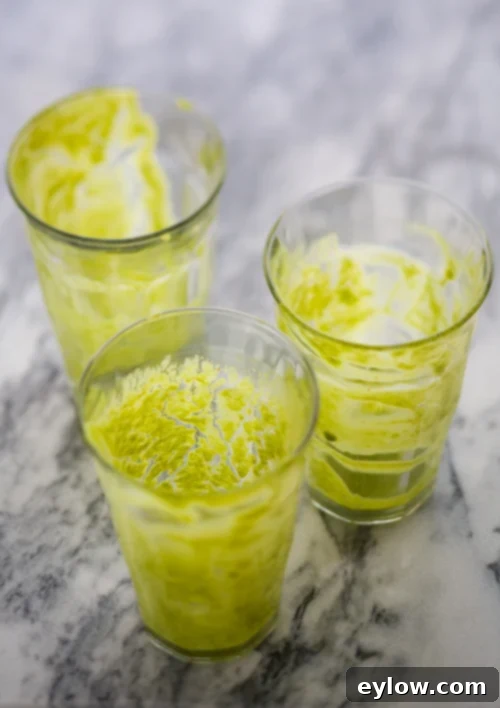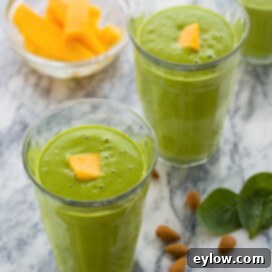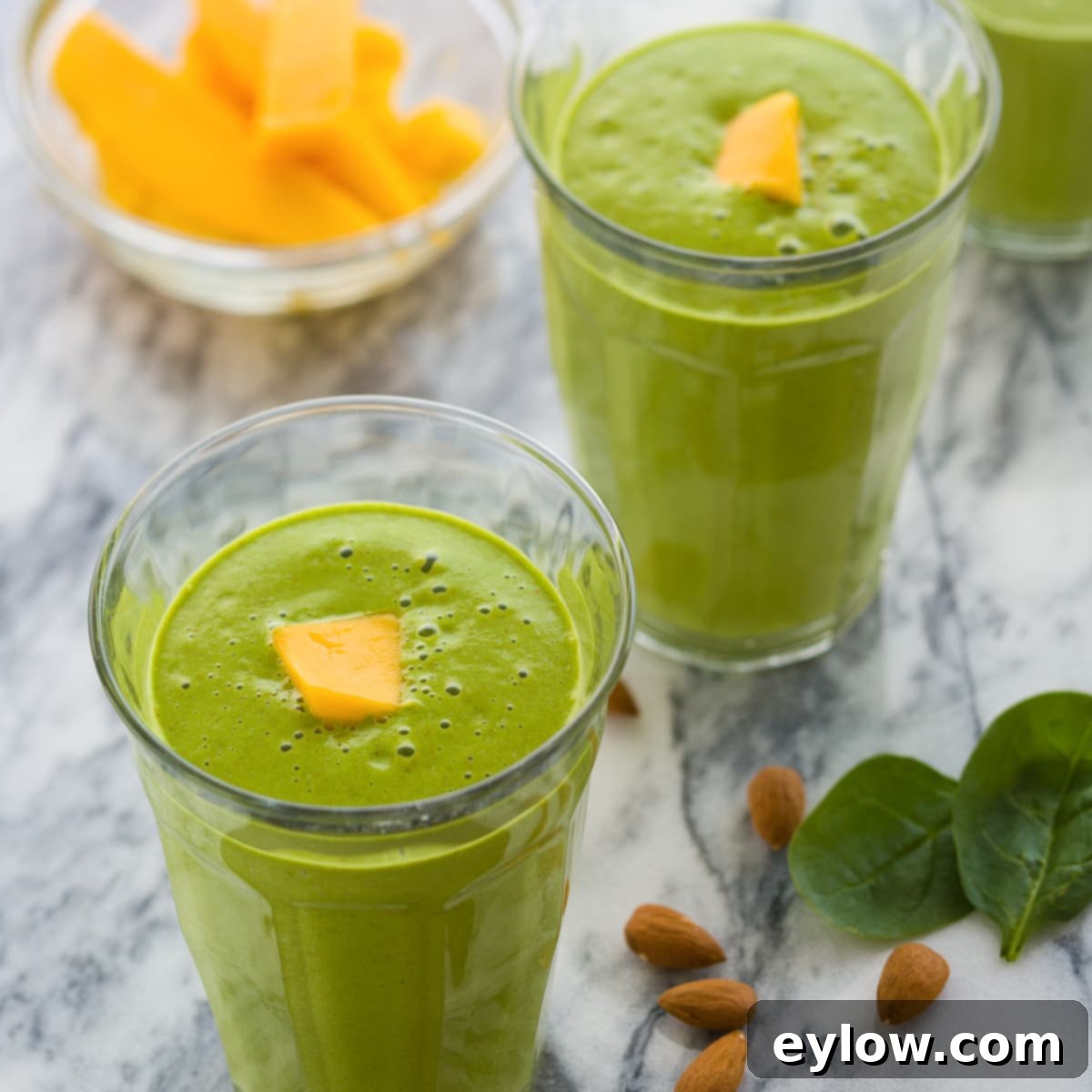Tropical Mango Green Smoothie: Your Ultimate Guide to a Deliciously Healthy Breakfast
Embark on a delightful culinary journey with this simple, tropical **green smoothie recipe**. Crafted with succulent mango, fresh baby spinach leaves, powerhouse chia seeds, and creamy homemade almond milk, this vibrant beverage is more than just a drink; it’s a refreshing escape to the tropics. Don’t let its striking green color deter you – beneath that verdant hue lies an incredibly delicious and nutrient-packed treat! Smoothies are an exceptional way to kickstart your day, offering unparalleled convenience. They blend up in mere seconds, are perfectly transportable for busy mornings, and can be effortlessly customized to satisfy individual tastes and dietary preferences. It’s a perfect blend of deliciousness and health!

For quite some time, I found myself tethered to my beloved raspberry-banana smoothie routine. While undeniably tasty, I felt it was time to branch out and infuse my mornings with exciting new flavors. A generous gift of a half-dozen ripe mangoes from the National Mango Board instantly sparked the idea for a tropical smoothie creation. Mangoes, with their inherently sweet and exotic essence, effortlessly transport you to sun-drenched beaches. While the notion of combining mango with fresh spinach leaves might initially sound unconventional, I assure you, it results in an absolutely terrific and surprisingly harmonious smoothie.
How to Choose a Perfectly Ripe Mango
Selecting the ideal mango is key to a flavorful smoothie. To choose a ripe mango, begin by gently squeezing it. A perfectly ripe mango should yield slightly to pressure, much like a ripe peach or avocado. It should feel firm yet possess a noticeable give. Contrary to popular belief, the color of the skin is not the most reliable indicator of ripeness; many varieties can be green, red, or yellow even when ripe, so always rely on the touch test. If your mango feels hard, simply allow it to ripen at room temperature for a few days until it achieves the desired softness. Once ripe, you can refrigerate it to extend its freshness for approximately 5 days. Should your mangoes become overly soft before you have a chance to use them, don’t let them go to waste! Peel, cube, and freeze the flesh. Frozen mango is excellent for smoothies, providing a frosty texture without needing ice.

Mastering the Art of Cutting a Mango
For those new to mango preparation, cutting this luscious fruit can seem a bit daunting at first due to its large, flat, center seed. However, with a few simple tips, you’ll be slicing like a pro in no time.
Step-by-step guide to cutting a mango:
- Wash the Mango: Always start by thoroughly washing the exterior of the mango.
- Position for Cutting: Stand the mango upright on your cutting board, with the stem end facing up. Imagine the flat, oval seed running through the center of the fruit.
- Slice the “Cheeks”: Carefully cut a little off-center, approximately ¼ inch from the widest part of the mango, slicing down through the flesh from top to bottom. This will yield a large, fleshy piece often referred to as a “cheek.” You might need to make a couple of small adjustments with your knife to find the perfect cutting line and avoid hitting the seed directly. If your knife encounters resistance from the seed, simply adjust your cut by another ¼ inch and try again. Repeat this process on the other side of the mango to get the second cheek.
- Score the Flesh: Once you have successfully removed both “cheeks” from the seed, take a sharp paring knife and gently score the mango flesh in a grid pattern. Make sure not to cut all the way through the skin.
- Scoop out the Cubes: Using a spoon, scoop out the perfectly diced mango cubes directly into your blender or a bowl.
- Harvest Remaining Flesh: What’s left will primarily be the large seed. You may be able to carefully trim a small amount of additional flesh from around the edges of the center piece, but generally, the majority of the usable fruit comes from the two cheeks.
For a visual demonstration and more in-depth information, including a helpful video tutorial on how to cut a mango, be sure to visit the National Mango Board website.
Delving Deeper into Healthy Smoothie Ingredients
Baby Spinach Leaves: The Unsung Hero of Green Smoothies
This green smoothie owes its stunningly bright and inviting color to fresh baby spinach leaves. While adding spinach to a sweet fruit smoothie might initially strike you as unconventional, it is hands down one of the easiest and most effective ways to incorporate leafy greens into your diet right at the start of your day. You won’t even taste it! Simply add about a cup, or a generous handful, to your blender. Spinach is an absolute nutritional powerhouse, widely regarded as one of the world’s healthiest vegetables. It’s incredibly rich in essential vitamins like K, A, and C, as well as vital minerals such as iron and magnesium. Furthermore, it boasts significant anti-inflammatory benefits and powerful antioxidants that contribute to overall well-being. Its mild flavor is perfectly masked by the sweetness of the mango and banana, making it an ideal “hidden vegetable” for even the pickiest eaters.
Chia Seeds: Tiny Seeds, Massive Benefits
Another incredible addition to this nourishing green smoothie is the mighty chia seed. These tiny seeds have a long history, cherished by ancient Aztec Indians for their remarkable ability to provide sustained strength and energy. Today, we understand why: chia seeds are an excellent source of omega-3 fatty acids, crucial for brain health and reducing inflammation, and an abundance of dietary fiber, which promotes digestive health and prolonged satiety. Beyond that, they pack a punch of calcium, iron, potassium, and plant-based protein, making them a comprehensive superfood. The brand I personally trust and buy is Navitas Naturals. Renowned for their high-quality products, their chia seeds are organic, non-GMO, raw, gluten-free, and vegan-friendly. I highly recommend exploring their other fantastic product offerings; they provide a wealth of healthy ingredients to enhance your smoothies and your diet overall. Truly superfoods!
Almond Milk and Other Liquid Bases
Homemade almond milk forms the creamy, neutral base for this smoothie, allowing the tropical flavors of mango and the freshness of spinach to shine. Making your own almond milk ensures you control the ingredients, avoiding unwanted sugars or additives often found in store-bought versions. However, if time is short, a good quality unsweetened store-bought almond milk works perfectly. For those looking to experiment, coconut water can add an even more pronounced tropical note and extra electrolytes, while regular water is always an option for a lighter, calorie-reduced alternative. Feel free to use any plant-based milk that suits your dietary needs, such as soy, oat, or cashew milk.
The Sweetness and Creaminess of Banana
A half banana in this recipe plays a crucial dual role: it adds natural sweetness and contributes significantly to the smoothie’s creamy texture. For a frosty smoothie without added ice, consider freezing your banana slices ahead of time. A ripe banana will provide more sweetness, while a slightly greener banana can help reduce the overall sugar content if that’s a concern for you.
Boost Your Smoothie with Protein Powder
Adding 1-2 scoops of your preferred protein powder is an excellent way to elevate this smoothie from a simple snack to a more substantial and satisfying meal. Protein is vital for muscle repair, growth, and prolonged satiety, helping to keep you full and energized throughout the morning. Whether you opt for a whey, casein, plant-based (pea, rice, soy), or collagen protein powder, choose one that aligns with your dietary needs and flavor preferences. Unflavored protein powder is ideal for not interfering with the delicious mango and spinach taste.
Crafting Your Perfect Smoothie: Tips and Customizations
Once your mango is expertly cubed, gather your high-powered blender or Vitamix, ready your fresh spinach, preferred almond milk, and nutrient-dense chia seeds. You’re now just moments away from enjoying a truly fantastic and healthy smoothie!
Blender Best Practices
For the smoothest and creamiest results, the order in which you add ingredients to your blender matters. Always start with your liquids (almond milk) at the bottom. This helps the blades move freely and prevents ingredients from getting stuck. Next, add soft ingredients like spinach and fresh mango. Finally, add harder or frozen ingredients like frozen mango cubes or banana. This layering ensures everything blends efficiently and thoroughly.
Achieving Your Ideal Consistency
The beauty of homemade smoothies is the ability to customize texture. If you prefer a thicker smoothie, use less liquid or add more frozen fruit (like frozen mango or banana) or a handful of ice cubes. For a thinner consistency, simply add more almond milk or water until you reach your desired pourable texture.
Customization and Variations
While this tropical mango green smoothie is perfect as is, it’s also a fantastic canvas for experimentation:
- Other Fruits: Pineapple chunks, peaches, or a few berries can complement the mango beautifully.
- Other Greens: A small amount of kale can be added for extra nutrients, though spinach is milder.
- Superfood Boosts: Consider adding a teaspoon of spirulina for an even greater nutrient punch, or a tablespoon of ground flaxseed for more omega-3s and fiber.
- Spices: A small piece of fresh ginger or a pinch of turmeric can add warmth and additional anti-inflammatory benefits.
The Unbeatable Benefits of Daily Green Smoothies
Incorporating green smoothies into your daily routine offers a multitude of health advantages. They are an incredibly efficient way to consume a wide array of vitamins, minerals, and antioxidants from fruits and vegetables in a single, delicious serving. The high fiber content from ingredients like chia seeds and spinach promotes healthy digestion and helps regulate blood sugar levels, preventing those mid-morning energy crashes. Furthermore, smoothies are excellent for hydration, especially when using water or coconut water as a base. They provide sustained energy, support immune function, and can even assist with weight management by keeping you feeling full and satisfied. This mango green smoothie is not just a drink; it’s a commitment to a healthier, more vibrant you!
Another Great Mango Recipe Idea
If you find yourself with an abundance of mangoes and are looking for other delightful ways to enjoy them, I highly recommend trying this refreshing pineapple-mango salsa. Its vibrant flavors and textures make it an incredible accompaniment to grilled chicken, succulent shrimp, or flaky fish, adding a taste of the tropics to any meal.

📖 Recipe

Green Smoothie Recipe with Mango
Sally Cameron
Pin Recipe
Equipment
-
blender
Ingredients
- 10 ounces almond milk preferably homemade
- 1 big handful baby spinach leaves
- 1-2 scoops preferred protein powder
- ½ cup cubed mango fresh or frozen
- 2 tablespoons chia seed
- ½ banana
Instructions
-
Place all ingredients into your blender in the order given (liquid first, then soft ingredients, then hard/frozen).
-
Process on high speed until you reach your desired smooth and creamy texture. Add more liquid if needed to achieve a thinner consistency. Serve immediately.
Notes
Nutrition
